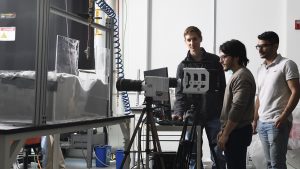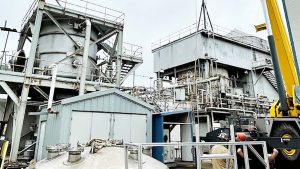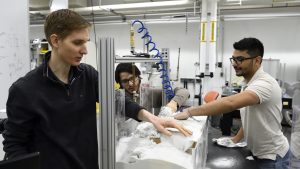
For the first time this century, NASA plans to send humans to the moon, perhaps as soon as 2025. Humans haven’t landed there since the last Apollo mission in 1972. The plan this time is to stick around. The agency wants to establish a permanent lunar base to serve as the staging ground for the next era of space exploration: sending the first astronauts to Mars.
From its gargantuan craters to its ancient volcanoes, the moon is a scientific treasure trove that can tell us more about Earth and the solar system. Samples collected during the Apollo missions have helped scientists learn a great deal in the decades since.
But building a long-term presence on the moon presents a daunting range of technological and safety obstacles. NASA has enlisted a team of experts to work on a slew of research problems related to the mission, dubbed the Artemis program. Part of that team includes mechanical engineering graduate students Juan Sebastian Rubio, Miguel X. Diaz-Lopez, and Matt Gorman, all members of Rui Ni’s Fluid Transport Lab. The trio ran a series of experiments to understand plume surface interactions— or what will happen when a landing spacecraft approaches the lunar surface.
As more permanent bases are installed on the moon, sustaining life there will require more people, more supplies, and larger payloads. That means NASA will be sending landers that are 10 times heavier—and more powerful—than those sent 50 years ago, says Rubio, a NASA Space Technology Graduate Research Fellow.
“What we don’t know is how that will affect the lunar surface. What happens to the soil below the spacecraft as it lands? Where are the displaced particles going, and how fast?” he says. “Currently, there isn’t a lot of modeling that can fully predict the effects. We want to understand the physics behind this so we can predict future landings with more certainty.”
As a spacecraft lands, engine exhaust plumes erode the lunar surface, kicking up dust, rock, and soil. Erosion can lead to deep craters under the lander, causing it to become unstable and topple over. And don’t let the term “moon dust” fool you: This substance is as jagged and sharp as broken glass, and more than capable of damaging spacecraft and equipment.
“Mitigating landing risks is critical if we want to make routine trips to the moon. Even a relatively small thrust can send dust and rock particles flying at terminal velocity. If those hit nearby structures, we could be destroying the base every time we resupply,” says Gorman.
Of course, the moon has only one-sixth of Earth’s gravity and no atmosphere, making the lunar surface a perpetual vacuum. So observing plume surface interaction as it would occur on the moon requires an experimental setup mimicking those atmospheric conditions.
In summer 2021, the team headed to the NASA Marshall Space Flight Center in Huntsville, Alabama, and set up in the center’s 15-foot vacuum chamber, modified to study surface erosion under near-lunar and Martian conditions.
“There are only a few chambers of this kind in the world. The fact that we were able to get in there and run our own experiments was incredible,” says Gorman.
The team spent nearly two months devising a synchronized six-camera diagnostic system to study erosion caused by a gas nozzle running above a bed of simulated lunar soil. Using this setup, they captured crater formation and tracked the trajectory and velocity of the small soil particles. With this information, the team developed a model to predict cratering under any atmospheric conditions, a significant contribution to understanding plume surface interaction in space.
“The whole point is to understand the interaction between the lander’s retropropulsive exhaust and the surface of the moon. No one has data like this, and it’s highly valuable for SpaceX and Blue Origin, who will design the next generation of lunar landers,” says Diaz-Lopez, another NASA Space Technology Graduate Research Fellow.
Now back in Baltimore, the team continues work with NASA collaborators on a deeper analysis of its findings. They have presented their work at two major conferences and have plans to publish the results in a peer-reviewed journal.
All agree that working on a large, multidisciplinary research team has been valuable in showing them what life will be like when they leave Johns Hopkins.
“In the lab, we don’t work with a huge team on a regular basis. We met so many experienced NASA engineers who gave us suggestions and respected our ideas,” says Diaz-Lopez.
One thing is certain: When the next person steps foot on the moon, Johns Hopkins researchers will be among those who made the mission possible.
“Our data is going to be used to guide future missions to the moon, Mars, and other planets,” says Rubio. “It is very inspiring for me to be working alongside NASA scientists on a project of this magnitude. Our work will directly impact future space exploration and get us closer to sending the first humans to Mars.”
Mission Ready
Preparing for NASA's Artemis Missions

The team built a synchronized six-camera diagnostic system to study erosion caused by a gas nozzle running above a bed of simulated lunar soil. -

The team ran their experiments in NASA's Experimental Facility in Huntsville, Alabama. -

Inside NASA's 15-foot vacuum chamber, modified to study surface erosion under near-lunar and Martian conditions. -

The team's system captured crater formation and tracked the trajectory and velocity of the small soil particles. -